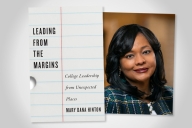You have /5 articles left.
Sign up for a free account or log in.
Women's studies programs, now common, were rare on campuses just a few generations ago. The evolution of the discipline, and its status in academe today, are the subjects of the essays in The Evolution of American Women's Studies: Reflections on Triumphs, Controversies and Change (Palgrave Macmillan). Alice E. Ginsberg, an education consultant who edited the volume, responded to questions about its themes, citing the authors of essays in the collection.
Q: What were the key challenges to women's studies in the early years of its development?
A: Feminist scholar Jean Robinson has written that: "When women’s studies was born in the mid-1970’s, politics was its mid-wife." Marilyn Boxer echoes this sentiment when she writes that when women’s studies first entered the university “merely to assert that women should be studied was a radical act.” One of the key challenges to women’s studies in the early years was most certainly that it was intimately connected to the feminist movement for social change. It was, in fact, referred to as the “academic arm” of the women’s movement. These first courses, and the brave women who taught them, made no bones about the fact that knowledge was political (e.g., right answers often depend on one’s perspective, and we need to ask questions not only about what is taught, but what is left out). Women’s studies also distinguished itself by claiming that the personal was political, and thus making a place within courses for women to talk about their own experiences, expectations, and socialization.
For too long the university had privileged the study of white middle class heterosexual men. Needless to say, to those in power (e.g. white middle class heterosexual men) the introduction of women’s studies was very threatening. Indeed, Pat Robertson was quoted in a fund-raising letter as follows: "The feminist agenda is not about equal rights for women. It is about a socialist, anti-family political movement that encourages women to leave their husbands, kill their children, practice witchcraft, destroy capitalism, and become lesbians.”
Not only did women’s studies professors have to challenge these kinds of statements, but in the early years there were no women’s studies “departments” or funding for those who wanted to teach women’s studies classes. Most early women’s studies classes were held by word of mouth and for free, sometimes in instructors’ homes, and in at least one instance, in the ladies room.
Another sticking point in women’s studies was its inherently interdisciplinary nature. While this is certainly not a bad thing, women’s studies teachers were worried that they would be looked at suspiciously in their home disciplines, and may even be denied tenure because of it.
Finally, I can speak here from my own experience as one of the first generation of women who had the opportunity to actually major in women’s studies. I was constantly bombarded by questions such as: “What are you going to do with it?” I finally got fed up and published my answer in a prominent spot in Temple University’s alumni magazine: “To ask, What are you going to do with it? implies that education is a passive process. It implies that we learn and then we do. But in many ways the very nature of women’s studies, which grew out of and alongside the women’s liberation movement, is attractive because it is already active. Women’s studies grew out of the political realities of women’s lives…. I learned that theory and practice should go hand in hand. I learned that education should be about change and evolution, and not just about reiterating what is already known. I take that knowledge with me to each job I do, and do with it – whatever I can.”
Q: In what ways do you see women's studies as similar or different to black studies or programs of study that focus on other ethnic or racial groups?
A: The similarities between women’s studies and, for example, black studies (also referred to as African American studies) are clear in that they both promote the idea of learning for social change and action, as well as restoring lost histories, and allowing silenced voices to be heard. Indeed, many of the same people who were active in the women’s movement were active in the civil rights and anti-war movements as well.
There are differences, however. Most notably, women’s studies has historically been accused of focusing on the experiences of white women, and not adequately addressing issues of race, ethnicity, class, religion and sexuality. The idea of women’s studies suggests that there is something that unites all women, but the differences among women are as salient as the similarities. Moreover, the use of the term “women of color” is problematic because it suggests that white women are the “norm” and everyone else is clumped into one single category of difference.
It should also be noted that while one of the primary goals of both the women’s movement and women’s studies is equality with men, not all men are equal in American society. Bell Hooks eloquently raises the question: “Since men are not equals in a white supremacist, capitalist, patriarchal class structure which men do women want to be equal to?” While more women’s studies professors are addressing the issue of race and class, there is still much more work to be done here.
There has also been a long-standing debate as to whether women’s studies should remain its own department and/or discipline, or whether it should be integrated into the entire academic curriculum. This raises a third possibility, that of alliances among women’s studies and other cultural/ethnic studies programs. Such alliances are slowly building, yet it is still unclear exactly how these various programs can best work together.
Q: How would you evaluate the success of women's studies today?
A: There is no question that women’s studies has been and is a very successful venture. There are over 800 women’s studies programs nationwide, including the opportunity to get a Ph.D. in women’s studies, and to take courses online. Also, as previously mentioned, the creation of the National Women’s Studies Association was instrumental in that it provided a forum for women’s studies scholars to share resources and network. The success of women’s studies is also found in the huge proliferation of books, journals, networks, blogs, and conferences about the field -- both nationally and internationally. The genuine inclusion of “women of color” (which I use in quotes) is still a challenge for the field, but there are many prominent women’s studies scholars who are of different races and ethnicities.
The other great success of women’s studies is that in the early 1990’s several significant studies came out about how girls were being “short-changed” or “cheated.” The issue of gender bias and gender socialization in primary and secondary schools became big news. It was discussed on popular talk shows such as "The Oprah Winfrey Show," and featured in prominent news journals like Newsweek.
In recent years there has been a lot of scholarship about how boys too are subject to discrimination and being socialized into narrowly defined gender stereotypes. There is a pressing need to move beyond gender polarities (e.g., if girls win boys lose and vice versa), by raising issues of awareness and equity for both sexes. In the K-12 environment it is also vital to make connections between the importance of studying gender and more recognized school problems like teen pregnancy, sexual harassment, high dropout rates, and school violence.
Q: There is some discussion in the women's studies world about the wisdom of changing program names to gender studies or variations on that. How do you see that issue?
A: This is perhaps the toughest question facing women’s studies today. Many women’s studies programs have included the word gender, or changed their name entirely to “gender studies.” There are also possible variations on this, such as “female studies” or the slightly riskier “feminist studies.” I posed this very question to the contributors of the book, and they were very divided in their answers. Some felt that using the word gender calls attention to the fact that gender is a socially constructed category, which may include transgendered individuals, and is more likely to look at differences among women based on race and class, etc. Perhaps the most compelling argument for changing the name to gender studies is that it invites men to look at their experiences in American culture, as well as how they may be complicit in the continuation of systems of power and privilege. It also compels men to see themselves not as the “norm” but as gendered human beings.
On the other hand, we can’t overlook the significance of the apostrophe in the name women’s studies. Born from the women’s movement, women are finally claiming their own lost histories and taking the lead in challenging the social construction of knowledge. There is no such “gender movement” to speak of.
One thing is clear, whatever we call it, women’s studies needs to be feminist in nature, and to make use of feminist pedagogy, or it risks losing what makes it unique. As someone posted on a women’s studies e-mail list: “We need to destabilize gender at the same time we insist that historically and politically a category or class of individuals called women have been systematically oppressed.” This is a tricky position to be in, for sure.
One last point on this topic: many women’s studies programs are including sexuality in their titles. While on the surface it makes sense that sexuality studies would have a home in women’s studies, it does raise issues as to why the explicit inclusion of sexuality but not race or class.
Q: Women's studies continues to be a target of criticism from conservatives. Why do you think that's the case?
A: All I can say here is that this is actually a good thing, a very good thing. As DuBois has noted: “If our work is not in some way threatening to the established order, we’re on the wrong track.”
The whole idea of women’s studies is to make visible what has been invisible and to make conscious what has been overlooked or silenced. Moreover, feminist pedagogy – which suggests social change and action are implicit in any kind of learning – will always run counter to the “objective,” “rational” way in which the University traditionally looks at research and knowledge. In women’s studies classes, teachers do not claim to be the only “expert”; student voices count for a lot. And the inclusion of service-learning projects as part of women’s studies programs is growing rapidly.
Earlier in this interview I noted that women’s studies was looked at as the academic arm of the women’s movement, but it has also been said that this arm is in a sling – it critiques the academy while being part of it.








